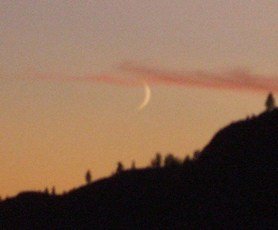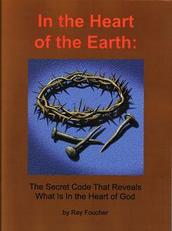When is Pentecost?
What Does the Bible Say?
The question of when is Pentecost is dependent on four factors that are commonly debated and one relatively unknown one that very few people have ever considered:
- Which new moon to start the month of Nisan?
- Which new moon, astronomical or visible crescent?
- The state of the barley in Israel
- What day of the week should start the count to Pentecost?
- Does the word "after" in Lev 23:11, 15 and 16 belong there?
This study will just briefly mention the first four factors for background information. Then it will focus on number 5 - a factor that most people are not even aware of.
1. When is Pentecost? - It Depends Which New Moon is Used to Start the Month of Nisan.
Some people say the new moon to be used should be the one closest to the spring equinox and others say that it should be the new moon following the spring equinox.
"This month shall be unto you the beginning of months: it shall be the first month of the year to you." (Exo 12:2)
The month referred to is the spring month of Nisan. The question is can the first month ("the beginning of months") of the year start before the year has started?
2. When is Pentecost? - It Depends Whether the Astronomical New Moon or the Visible Crescent is Used to Determine the Beginning of the Month
The exact time of the astronomical new moon cannot be determined by simple visual means as the moon is dark at that time; actually it is not visible for a few days. Proponents of using the astronomical new moon time say that it can be calculated very accurately and indeed it can be but was that always possible? There seems to be considerable documentation of people watching for the new crescent moon from Jerusalem and then announcing it (even by lighting signal fires on hilltops) throughout Israel.
3. When is Pentecost? - It Depends on the State of the Barley Crop in Israel
This is a factor as ripe barley is required for the wave sheaf offering that marks the start of the count to Pentecost. There are obviously differences about this as the two paragraphs below illustrate. I don't feel I have investigated this thoroughly enough yet to be sure.
One article I received on April 4, 2010 referred to confusion among feast keepers caused by the teaching that "March 29th, 2010 was Passover, based on the barley in Jerusalem." The article went on to say that the proponents of this "have a problem, should they return to Jerusalem now to harvest the barley, they will find that only 15% of the barley in and around Jerusalem, as we speak is ready for harvesting. This means that 85% will have to wait until later this month after the real Passover, when it ripens, so as to obey the command to harvest it after Passover."
Another article I received read: "On Tuesday I went with _____ and we searched for the Barley to see what state it is in now just before Passover. We found barley by the fields full ready and Aviv. We also found fields where the barley had already reseeded itself. If you were to wait as some new groups now claim then by the time they keep Passover next month then a lot of barley will already be reseeded and the farmer will have missed the narrow opportunity to harvest it because you cannot harvest it until you first make the wave sheaf offering which is on the morrow after the weekly Sabbath and is Sunday. This Sunday April 4th, 2010."
If you don't live near Jerusalem and are going by this factor, it is going to depend on who you listen to. Personally, I see this factor as more of a confirming factor rather than a determining factor which the astronomical factors are.
4. When is Pentecost? - It Depends on What Day of the Week is Used to Start the Count to Pentecost
In Exodus, it is clear that the feast of unleavened bread was to start on the day after the Passover sacrifice was offered. This would be Nisan 15 and could therefore be on any day of the week. They were to eat unleavened bread for seven days from Nisan 15 to Nisan 21.
However, there is another day involved in determining the timing of Pentecost. The Feast of First Fruits is referred to in these two verses:
"And he shall wave the sheaf before the LORD, to be accepted for you: on the morrow after the sabbath the priest shall wave it." (Lev 23:11)
"And ye shall count unto you from the morrow after the sabbath, from the day that ye brought the sheaf of the wave offering; seven sabbaths shall be complete:" (Lev 23:15)
This verse indicates the day from which to start the count in two ways:
- start "from the morrow after the sabbath"
- start "from the day that ye brought the sheaf of the wave offering"
It would seem to indicate to start on a Sunday, logically the day after the seventh-day Sabbath that comes during the Feast of Unleavened Bread. Then the end point is specified by this verse:
"Even unto the morrow after the seventh sabbath shall ye number fifty days; and ye shall offer a new meat offering unto the LORD." (Lev 23:16)
There is an interesting point about verse 16. If the count was to start on any day of the week then it would end on the fiftieth day on the same day of the week. Say it started on a Tuesday. When day 50 came along, also on a Tuesday, what would the seventh sabbath be referring to? Day 49 of the count is not a sabbath. Monday is certainly not a sabbath. The start of the count must be connected to a seventh-day Sabbath.
5. When is Pentecost? - It Depends on Whether the Word "After" Belongs in Leviticus 23:11, 15 and 16.
Here is the surprise factor in answering the question when is Pentecost: The word "after" in the three verses above does not belong there! It is not in the original.
Read about the
one little-known factor regarding the date of Pentecost
that is very important in answering the question "when is Pentecost?"
|





New! Comments
Have your say about what you just read! Please leave a comment below.